![[Seven of Nine Guarding While Shadow and Pups Observe]](ritepups.jpg)
![[Seven of Nine Guarding While Shadow and Pups Observe]](ritepups.jpg)
 Phone Numbers Link
Phone Numbers Link
The following three part article was published in the Anatolian Times. Part I was published in Volume 37 in 1991, Part II in Volume 39 in 1992, and Part III in Volume 40 in 1992. The cover picture of Volume 40 is of Ebling's Kasif (CASY) guarding me (lying on the ground taking a picture of my house) from my cows. Casy was my first Anatolian Shepherd Guardian Dog, had incredible guardian ability, and is the foundation sire of my bloodlines. Volume 40 of the Anatolian Times, with Casy's picture on the cover, was the second time a picture of an Anatolian Shepherd belonging to a member of ASDCA was placed on the cover!
In addition, this article was translated into Swedish (? I can't read
it!) and printed in their "Anatolian Times" called Paskutgava in April 2002
and Anatolian Shepherd Dogs International, Inc printed the article
in Choban Chatter, 2002, Volume 12, Issues 1, 2 and 3.
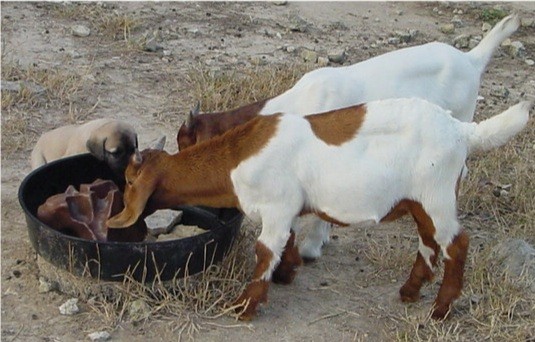 I don't handle the pups for the first two weeks except for a short trip
to the vet to have the dew claws removed on day three. Then, at two weeks
of age, I begin allowing my pups to nurse my milk goats. This enhances identification
with the goats. At this age, nursing the goats twice daily is sufficient
to supplement the bitch's milk.
I don't handle the pups for the first two weeks except for a short trip
to the vet to have the dew claws removed on day three. Then, at two weeks
of age, I begin allowing my pups to nurse my milk goats. This enhances identification
with the goats. At this age, nursing the goats twice daily is sufficient
to supplement the bitch's milk. 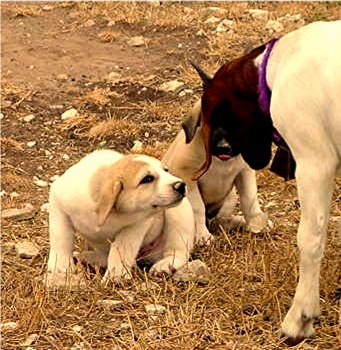
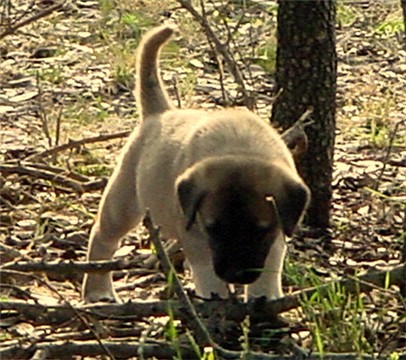 I move the pups at six weeks to eliminate as many external and internal
parasites from them as possible. After two weeks in the new communal pen,
I again worm each pup for roundworms, dip them for fleas and ticks a second
time, and move each pup to another new pen; this time I construct a separate
pen for each pup. Although I believe it is ideal to have three or more goats/sheep
in each pen, I settle for one goat per pen, since my pens for this phase are
only temporary.
I move the pups at six weeks to eliminate as many external and internal
parasites from them as possible. After two weeks in the new communal pen,
I again worm each pup for roundworms, dip them for fleas and ticks a second
time, and move each pup to another new pen; this time I construct a separate
pen for each pup. Although I believe it is ideal to have three or more goats/sheep
in each pen, I settle for one goat per pen, since my pens for this phase are
only temporary. 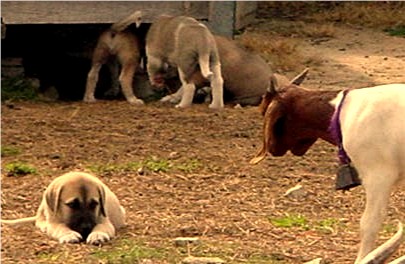 I also note any variation between the pup's natural determination to
stay with the herd. Since the pup is either learning the command, "Go to
the Goats!" or increasing its desire to follow the herd, the pup is learning
something desirable and I am gaining significant information regarding each
pup's natural guardian instincts and abilities.
I also note any variation between the pup's natural determination to
stay with the herd. Since the pup is either learning the command, "Go to
the Goats!" or increasing its desire to follow the herd, the pup is learning
something desirable and I am gaining significant information regarding each
pup's natural guardian instincts and abilities.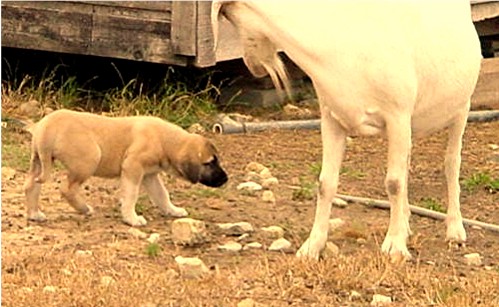 Pups placed with the correctly dominant sheep/goats will be taught the
precise attitudes, demeanor, stances, carriage, postures, and bearing that
allows them to most successfully blend with the herd. I believe that pups
who miss these initial sheep/goat interactions will never merge with the herd
as successfully as pups receiving these interactions. And inappropriate behavior,
such as chasing, jumping on, lacking respect for, biting, nipping, playing
with, and being inappropriately aggressive to, will be automatically corrected
as it occurs.
Pups placed with the correctly dominant sheep/goats will be taught the
precise attitudes, demeanor, stances, carriage, postures, and bearing that
allows them to most successfully blend with the herd. I believe that pups
who miss these initial sheep/goat interactions will never merge with the herd
as successfully as pups receiving these interactions. And inappropriate behavior,
such as chasing, jumping on, lacking respect for, biting, nipping, playing
with, and being inappropriately aggressive to, will be automatically corrected
as it occurs.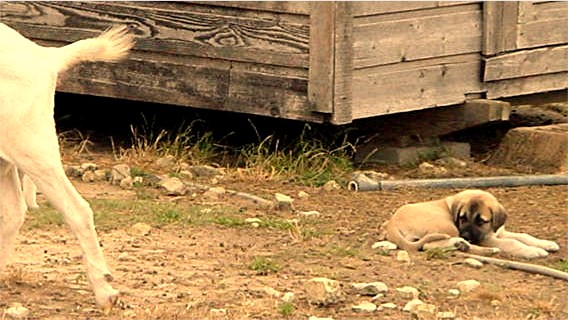 Behavior I watch for that I like and encourage includes, but is not limited
to, demonstrating a fondness and attachment for the herd, displaying immediate
sheep/goat submission to any herd animal in an aggressive posture, exhibiting
exaggerated care with younger, smaller, or injured herd animals, and displaying
protective and/or watchful conduct. I try to detect and encourage each of
these behavioral characteristics.
Behavior I watch for that I like and encourage includes, but is not limited
to, demonstrating a fondness and attachment for the herd, displaying immediate
sheep/goat submission to any herd animal in an aggressive posture, exhibiting
exaggerated care with younger, smaller, or injured herd animals, and displaying
protective and/or watchful conduct. I try to detect and encourage each of
these behavioral characteristics.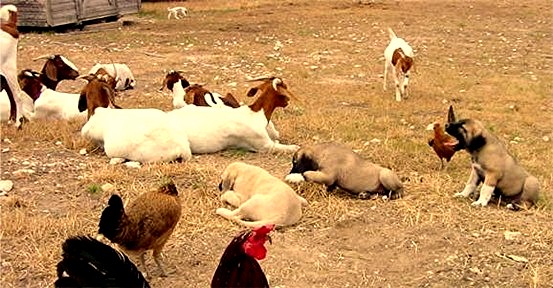
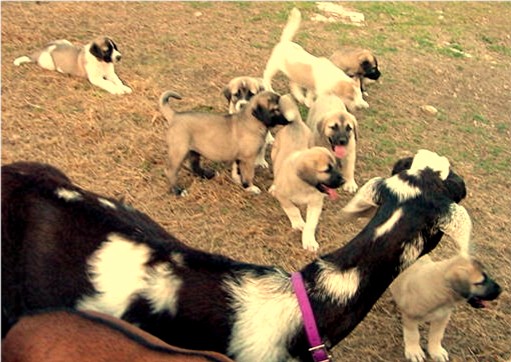 During these months, my feelings alternate between excitement and anxiety;
I experience great excitement and pride in my pup's accomplishments interspersed
with intense feelings of anxiety and depression over my inability to clearly
communicate the standards of behavior I expect the pup to maintain. When
a pup has exhibited outstanding guardian behavior, I feel elated and hopeful
that the pup has settled into a stable, reliable guardian pattern. But when
a pup engages in behavior I dislike, especially when I have already worked
to modify that undesired behavior, a feeling of hopelessness sometimes overcomes
me, causing me to temporarily fear that "this" pup lacks some essential element
necessary in true guardian dogs. It is incredibly demoralizing to believe
that nothing can be done to assist a pup to become the reliable guardian dog
the pup was obtained to become in the first place.
During these months, my feelings alternate between excitement and anxiety;
I experience great excitement and pride in my pup's accomplishments interspersed
with intense feelings of anxiety and depression over my inability to clearly
communicate the standards of behavior I expect the pup to maintain. When
a pup has exhibited outstanding guardian behavior, I feel elated and hopeful
that the pup has settled into a stable, reliable guardian pattern. But when
a pup engages in behavior I dislike, especially when I have already worked
to modify that undesired behavior, a feeling of hopelessness sometimes overcomes
me, causing me to temporarily fear that "this" pup lacks some essential element
necessary in true guardian dogs. It is incredibly demoralizing to believe
that nothing can be done to assist a pup to become the reliable guardian dog
the pup was obtained to become in the first place. At about four months of age, I make an appointment with the vet to vaccinate
my pups for rabies. (Four months is the age my vet recommends for rabies
vaccinations.) I use this trip to the vet to introduce each pup to the leash
and to gain additional information regarding each pup's basic personality.
Several days before this trip, I introduce each pup to the collar and
leash. Although this introduction is the first time the pups have worn a
collar, I have already familiarized them with the concept of being led. (When
I moved them between pens, I held the loose skin of their necks and encouraged
them forward by enthusiastically saying, "Good dog!" as they moved along
with my urging. However, I am aware that leading a pup by the skin of the
neck can be very intimidating to the pup, so I am especially careful to avoid
creating a situation in which the pups feel bullied.)
Since the pups understand the concept of being led, which involves submission
to my will, the lesson usually proceeds without incident. However, it is
essential to maintain a positive, encouraging attitude. The pup is generally
apprehensive, so I begin in the pup's pen. I remain calm, regardless of
the pup's reaction. And I always, always pull-release, pull-release on the
leash; never pull steadily without immediate release! A steady pull on the
lead may cause the pup to become sullen or to fall down passively. Alternately,
the pup may violently attempt to flee; it may throw its body backward in
terror at being so firmly secured around its neck. I have never had a pup
attack. My intention is to reassert myself to the pup as the pack leader.
I first teach the pup to merely "give" to the pressure by walking to the
pup's side and gently pulling-releasing. When the dog clearly understands
that it can avoid the pressure by giving in to it, I give it a short break,
then begin again. I next urge the pup forward (pull, then release, pull,
then release). Each time the dog moves forward, whether by my physical effort
or the dog's own, I say, "Good dog! Good dog!" with eagerness! I believe
that praise for correct behavior is the most important factor in any training
situation. As the pup realizes it must always yield to the collar's pressure
to remove the pressure, it quickly calms down. After this one short lesson,
I can lead the pup out of its pen and to my stock trailer for the trip to
the vet without a struggle.
Since the pups have not been in direct physical contact with another dog
since they were eight weeks old, I carefully note the reaction of each young
dog to the other dogs during this trip. When I return the dogs to their individual
pens, I again worm them for roundworms. I also reduce the protein level
of the dog food to around 18% and decrease the total food volume I feed each
pup to an amount the pup can consume within twenty minutes twice daily.
I do not believe in accelerating growth at this stage by full feeding a high
protein feed. I believe a pup that grow too rapidly at this stage is more
susceptible to bone, joint, and tendon damage than a pup whose growth occurs
more slowly.
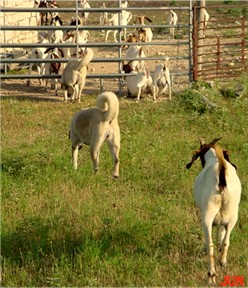 I believe that when the pup's growth is slowed to a more natural rate
for this breed, there will be very few problems with sprained ankles or other
limping problems due to excessively rapid growth. When a young dog has been
out to pasture with it herd and develops a limp, I reduce its overall food
volume and restrict its pen size until a week or so after the limp has disappeared.
Then I release the dog again and watch for any further problems. If further
problems occur, or the limp persists more than several weeks, I take the pup
to the vet for examination.
I believe that when the pup's growth is slowed to a more natural rate
for this breed, there will be very few problems with sprained ankles or other
limping problems due to excessively rapid growth. When a young dog has been
out to pasture with it herd and develops a limp, I reduce its overall food
volume and restrict its pen size until a week or so after the limp has disappeared.
Then I release the dog again and watch for any further problems. If further
problems occur, or the limp persists more than several weeks, I take the pup
to the vet for examination.
In selecting my own young dog, a trait I favor is a contained negative
and/or aggressive reaction toward new and unusual events or persons. If a
young dog will easily allow strangers to touch him, I doubt that dog's ability
to become truly devoted to the herd. Since I do not tolerate a dog that
engages in overt aggression toward sheep or goats and yet insist that a dog
exhibit aggressive-protective responses, a dog I will be pleased with must
be both exceptionally intelligent and genetically predisposed to correct guardian
behavior.
During these early months, especially when sheep or goats begin lambing,
the young dog must begin to integrate many conflicting and confusing instincts;
a pup has to determine the correct response to these instincts each time
it faces a new situation. A good pup desperately wants to be near and protect
the new borns and also to protect members of the herd. Therefore, when a
new born's mother attacks a young dog, that dog may analyze the situation
improperly; it may perceive the mother's protective response to be an attack
against the new born. And its response to that misperceived threat may be
to attack the mother to protect the new born, injuring the newborn in the
process.
I try to beware of misinterpreting dog/goat interactions, especially
during these early stressful, learning times. I attempt to understand why
a young dog acted in the manner in which it did. Was the pup confused? Did
the pup believe it was being protective, even when I perceived its actions
as destructive? For example, what may appear to me to have been unprovoked
aggression on the part of the pup may have seemed to the pup as necessary
aggression to protect a young goat/sheep. Before I decide my response to
the dog's action, I attempt to think through the situation from the dog's
perspective!
During this phase with my first Anatolian, Ebling's Kasif (Casy), I was
horrified to discover him eating a newborn. I was convinced he was ruined
and that there was nothing I could do to correct the situation. In an agony
of indecision and uncertainty, I did nothing except watch Casy "like a hawk."
Quite a few more lambs and kids arrived without incident. Then a young sheep
lambed and Casy took up his customary "lambing position" about 30 feet from
the mother (something he had learned earlier).
The lamb was particularly weak; I worried as I noticed the keen interest
Casy displayed toward this particular young lamb. Periodically Casy stood
up, walked slowly to the lamb, placed his muzzle by the lamb's nose, licked
the lamb gently and nurturingly, and then returned to his nearby position.
I checked the lamb several times myself and discovered it was very weak and
listless, barely breathing.
All afternoon and evening Casy's unusual lamb "inspection" kept repeating
itself. I was beginning to be unconcerned by his interest in the lamb when,
to my horror, Casy picked the lamb up in his teeth and walked away with it.
I yelled, "NO! DROP IT!" and he set it down and looked at me with a puzzled
expression. When I picked up the lamb, I knew it was dead.
I gave this incident a great deal of thought. I believe Casy's frequent
trips to the lamb were to check the lamb's breathing. As long as the lamb
was breathing, Casy remained watchful and protective. However, when the lamb
died, Casy felt free to dispose of it in the same manner a bitch with a new
litter disposes of any pups who die - by eating them. This trust I have
in Casy's reliability has been reinforced over the years by his incredibly
loving, protective attitude toward anything weak or helpless. To more fully
understand a young dog, I attempt to be present during that dog's initial
contact with a newborn. Also, my presence allows me to caution the pup to
move slowly and show respect for both the baby and the uneasy mother, if
necessary.
During this initial introduction, I am especially pleased with a pup
that falls to the ground immediately in response to a nervous mother's first
aggressive move. I am even more pleased if a pup crawls with slow eagerness
toward the newborn, especially if the pup crawls on its side, maintaining
the lowest possible profile. I like to see a pup stop moving when an agitated
mother butts it. I like a pup who remains passive under this assault until
the mother backs off, then who slowly continues crawling on toward the newborn.
When a pup reaches the weak, wet newborn, I favor a pup who carefully, gently,
licks the kid with maternal affection or stands immobile above the newborn,
trembling with eagerness and exaggerated caution as the newborn nuzzles the
pup in an attempt to nurse. When I find a pup who will do all of these things,
and more, I know I have found a valuable working Anatolian.
However, every dog is different. Some young dogs display less tolerance
for severe correction from goats or sheep than others. Although I prefer
a dog that will tolerate a great deal of correction without complaint, I do
not want a dog to allow other animals to abuse it through extended, extensive
correction. The most intense conflicts between young dogs and goats usually
occur over either food or new borns, and each dog must learn when to take
a stand and when to back off.
Goats quickly learn to defer to young dogs who are particularly protective
of their food. However, because protection of their newborns is such a strong,
basic instinct, goats or sheep frequently attack a young dog that doesn't
either keep a respectful distance from their new born or maintain a properly
submissive attitude. Many young dogs, excited and confused by the smell of
the new borns, are unable to do either. Their inability to maintain the proper
distance and attitude may provoke a nervous new mother into a severe, sustained
attack.
When I am present, I give a young dog guidance in proper behavior only
if absolutely necessary. In future encounters, the dog's initial experience
is reinforced by other goats or sheep. If I am not present for this initial
encounter, most young dogs do fine on their own. However, I believe in neutering
any dog who remains unable to interact with new borns without considerable
assistance, even though, with supervision, the dog eventually learns to behave
correctly.
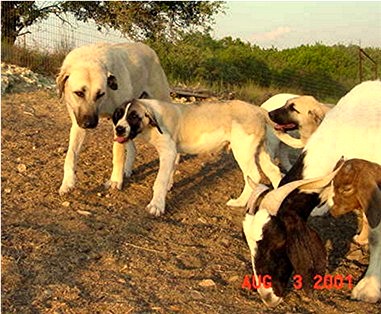 If the young dog was raised in a manner that created a strong bond with
goats and/or sheep, the dog will become a part of the herd. However, as a
young dog matures, it begins to explore to determine the limits of it's territorial
boundary. Some dogs are inclined to maintain very close contact with the
herd while others are prone to establish a more expanded area of protection.
If the young dog was raised in a manner that created a strong bond with
goats and/or sheep, the dog will become a part of the herd. However, as a
young dog matures, it begins to explore to determine the limits of it's territorial
boundary. Some dogs are inclined to maintain very close contact with the
herd while others are prone to establish a more expanded area of protection.
Even in large pastures, ranging too far from the herd is not desirable,
since the dog's absence leaves the herd vulnerable. In smaller pastures,
when the dog leaves the pasture, the herd is not only more vulnerable, but
neighbors can become upset, frightened, alarmed, or angered by the young dog's
unexpected presence, causing problems with the neighbors.
I decide early in the pup's life the extent of that pup's range. In
deciding that range, I consider a variety of factors. I don't expect any
dog to stay with the herd all the time. Guardian dogs instinctively mark
their territory. In smaller pastures I walk the boundary I want to establish;
I include the dog and the herd on this walk in order to reinforce in the
dog's mind the boundary I expect that dog to maintain.
Dogs strongly attached to the herd are generally content to stay with
the herd, inside the fence. However, even the best dog will ignore a fence
if the dog believes its boundary is beyond that fence. When my dog leaves
the herd (and my property), I try to immediately correct this unwanted behavior.
I attempt to convey to the dog my displeasure by forcefully ordering the
dog to return to the goats.
If my dog returns to this location, I greatly increase the level of
displeasure I display. This time, rather than verbally admonish the young
dog, I place the dog between myself and the goats and discharge my shotgun
into the air (I live in a location where this option is available to me.).
Most dogs will not require this level of response more than a couple of
times. I would rather shot into the air than have an irate neighbor shot
my dog! Hopefully, the dog now understands the limits I have placed on his
territory and will remain inside that area.
The only dogs I have successfully kept inside fences were raised from
puppyhood onward inside a fence that they could not go under, over, or through.
Once one of my pups has ever discovered it is able to cross a fence, that
dog has from that time on been able to go through any fence. My experience
leads me to believe that after an Anatolian has learned it can get out, it
cannot be contained when it decides to leave. This ability has both advantages
and disadvantages and increases the importance of the dog's understanding
of territorial limits.
Some dogs are more interested in chasing animals than others. A dog that
was properly conditioned by goats or sheep since birth generally develops
little interest in chasing young herd animals. But occasionally a young dog
will be especially playful. A playful pup that is deeply bonded to goats
can play too roughly, occasionally becoming rough enough to cause herd animals'
ears or legs to bleed. If this type of dog is placed with a herd that is
unfamiliar with guardian dogs, or animals that are less dominant than the
pup, the pup will be even more tempted to play chase and become too rough.
In this situation, I collar the dog and attach a rope to the dog's collar.
I attach a flat board about two feet long at the end of the rope. When the
dog merely walks, it easily drags the board. But if the dog begins running,
the board bounces about and hits the dog's front legs, providing instant correction
for negative behavior. When the dog has gained a little more maturity, I
remove the rope and board and expect the dog's to have no more interest in
chasing.
A pup who doesn't have incorrect behavior reinforced in a timely manner
may develop bad habits that are more difficult to correct. A pup I raised
begin playing with young chickens. Initially, the pup only chased the chickens,
pulling out a few feathers. I chided the pup, but was not too concerned at
the time. Later, I found several chickens with most of the feathers pulled
out of their backs. But since I didn't see the dog do anything, I did nothing.
Finally, I discovered a mangled, partially eaten chicken in the barn.
I punished the dog, but the behavior didn't stop. Each time I discovered
another partially eaten chicken, I felt defeated. I released chickens so
I could punish the dog immediately, but the dog just learned to avoid chasing
chickens in my presence. Finally, I tried a method that worked -- I scolded
the dog severely while holding the chicken under the dog's nose. Next I tied
the dead chicken in the dogs mouth for a couple of hours. (I used masking
tape.) When I removed the dead chicken from the dogs mouth I tied it under
the dog's chin in a manner that didn't allow the dog to play with the chicken
in any way. I kept the dog in a small pen during this phase. After a few
days, the chicken had decayed dreadfully, so I removed it.
I went through this cycle two times. The second time, I kept the chicken
tied in the dog's mouth six hours (I was very careful not to leave the dog
before I was certain that the dog was able to breath easily). After the second
time, the dog had no interest in chickens. Initially, I did not respond quickly
or forcefully enough to this situation. The more immediate the response,
the more likely the behavior will be modified successfully and permanently.
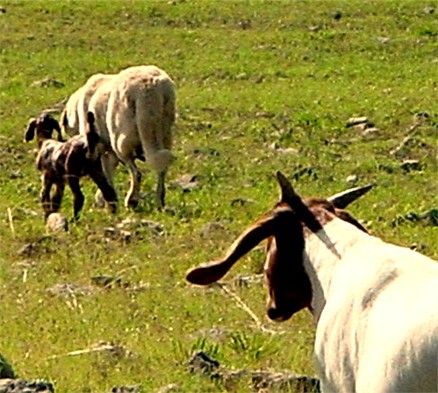 Raising an Anatolian puppy as a working guardian dog is hard work and
takes a great deal of time, effort, and thought. Many people do not have
the perseverance or the innate understanding of animals I believe is required
to successfully finish the task. These individuals will be too easily discouraged,
too easily upset, or too easily disappointed. I know that many dogs become
successful guardians without extensive thought or care on the part of their
owner. But I believe that most dogs develop at least some habits an owner
cannot accept and require some form of guidance and supervision. I also believe
that if an individual works with the dog intelligently and consistently and
has herd protection as his/her ultimate goal, the time and effort expended
is repaid by the dog tenfold!
Raising an Anatolian puppy as a working guardian dog is hard work and
takes a great deal of time, effort, and thought. Many people do not have
the perseverance or the innate understanding of animals I believe is required
to successfully finish the task. These individuals will be too easily discouraged,
too easily upset, or too easily disappointed. I know that many dogs become
successful guardians without extensive thought or care on the part of their
owner. But I believe that most dogs develop at least some habits an owner
cannot accept and require some form of guidance and supervision. I also believe
that if an individual works with the dog intelligently and consistently and
has herd protection as his/her ultimate goal, the time and effort expended
is repaid by the dog tenfold!
 Phone Numbers Link
Phone Numbers Link
 Click Picture to Return to Anatolian Main page
Click Picture to Return to Anatolian Main page
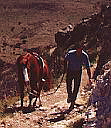 Click Picture to Return to Lucky Hit Main Home Page
Click Picture to Return to Lucky Hit Main Home Page
You can reach me by e-mail at:
ejc@ix.netcom.com